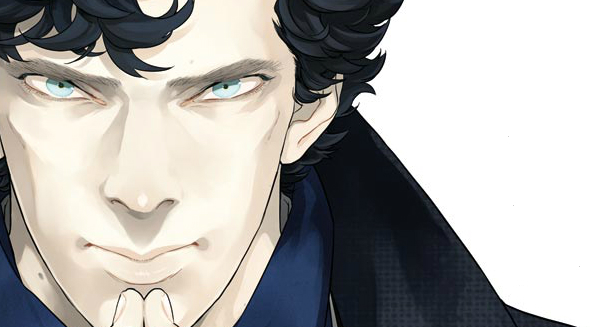
Written by Steven Moffat & Mark Gatiss
Art & Adaptation by Jay
Letters by Amoona Saohin
Review by Billy Seguire
 After six years and ten extended-length episodes, BBC’s Sherlock is nearly as famous as the Great Detective himself. It has achieved success international success, spawning a fanbase that crosses cultural boundaries to be recognized as a touchstone of modern storytelling. Originally published in 2012, Sherlock: A Study in Pink is the Japanese manga adaptation of the first episode of the modernized take on Sir Arthur Conan Doyle’s iconic character. The adaptation displays an intriguing look into how the series was interpreted across foreign cultures and Jay’s faithful retelling of the first episode accomplishes a great deal with only a small chunk of the original story. Nearly four years after its initial publication, Titan Comics are making this standout work available in North America and the UK for the first time.
After six years and ten extended-length episodes, BBC’s Sherlock is nearly as famous as the Great Detective himself. It has achieved success international success, spawning a fanbase that crosses cultural boundaries to be recognized as a touchstone of modern storytelling. Originally published in 2012, Sherlock: A Study in Pink is the Japanese manga adaptation of the first episode of the modernized take on Sir Arthur Conan Doyle’s iconic character. The adaptation displays an intriguing look into how the series was interpreted across foreign cultures and Jay’s faithful retelling of the first episode accomplishes a great deal with only a small chunk of the original story. Nearly four years after its initial publication, Titan Comics are making this standout work available in North America and the UK for the first time.
As a straight adaptation, the storyline of Sherlock: A Study in Pink will be familiar to anyone who’s seen the original episode. There doesn’t seem to be any major deviations taken from either Moffat’s script or the portrayal of characters, and although not covering the entirety of the episode within this single issue, there don’t seem to be many major omissions either. With A Study in Pink specifically taking place over six issues, it’s a fair bet to assume the retelling of the story will be unabridged. This first issue opens on a bit of a muddled note, as the book’s style fails to capture the intercut nature of these early scenes in a way that’s clean and visually obvious on the comic page. As soon as the action shifts to John Watson waking up in his flat, however, the book finds its footing and continues on a strong set of feet, running us through Holmes and Watson’s initial meeting and arrival at 221B Baker Street and cutting off at a natural transition point that feels like the right place to break off the opening chapter.
The black and white manga style allows Sherlock: A Study in Pink to hold some visual distinction. Jay’s original art captures the look of the series more accurately than I originally suspected it may, and while the manga style doesn’t totally suit itself to the locations and backgrounds of the series, characters are gorgeous. In its simplified form, Benedict Cumberbatch’s face maintains even more of the androgynous quality that makes his Sherlock seem so alien, while the soft and round features of Watson’s visual design make him the most easily accessible character of the book. Each character closely resembles the actor from the show and the spirit of their original performance is there, making memorable moments from the episode feel right as Jay renders small smiles and expressions into scenes. It’s a bit of a shame they didn’t take more liberties with the visual design, as the straight adaptation seems a trifle unfulfilling when we have the original episode to go back to. Part of the charm of a foreign adaptation comes from the cultural difference in the approach to telling the same story, but the changes found in Sherlock: A Study in Pink are unfortunately minor at best.
There is some exciting dramatic flourish to be had in the creative page layout. Jay doesn’t disappoint to render key moments of the episode in a way that maintains the feeling of those special live action moments to keep the pace varied. Sherlock’s gaze slicing through the page as he first observes John Watson, for instance, is a fantastic visual appeal. Similarly, when told about the fourth suicide, Sherlock’s energetic joy brings action and life into the staid square panels. The art somehow makes Sherlock even more enigmatic to readers than Benedict Cumberbatch’s original performance, a revelation I did not imagine possible. Martin Freeman’s much more subtle character of John Watson is also preserved, letting the humanity of the character draw the reader in. As we go inside of Watson’s head several times throughout the work, it seems right that our sense of perspective comes from him.
Apart from my appreciation for these stylistic embellishments, I found I had a difficult time engaging with Sherlock: A Study in Pink. Its main function seems to have been to translate the BBC story for Japanese manga-reading audiences. As a native English speaker reading the manga for the first time, I couldn’t help thinking that I’ve experienced this story before. I’m glad Titan is bringing it overseas so readers will have a chance to experience this adaptation, but I suppose I was hoping for a little more to be gained in translations. Those cultural quirks can be some of the most interesting parts of reading a book like this, and to me, and as faithful as the book was, it just felt like I was reading the story I already saw in 2010.
The Verdict:
Wait and See. If you’re a big enough fan of both Sherlock and manga as a storytelling medium to make this purchase worth it, rest assured that Jay has provided a faithful retelling of the episode with all its quirks and nuances intact. It’s a pretty straight adaptation, and apart from some dramatic flourishes, there’s little to differentiate this story from the one we saw on TV. Especially considering how it’s going to take six complete issues to tell the story of one television episode, it should take some thought before diving headfirst into buying this adaptation. There’s fun to be had in Sherlock: A Study in Pink #1. Just be warned it doesn’t add anything significantly new to the experience.
Sherlock: A Study in Pink #1 releases June 8, 2016



